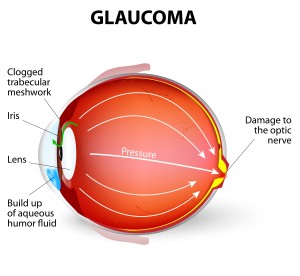Glaucoma
Glaucoma is referred to as the sneak thief of sight and can be present without a patient even knowing. As the nerve fibers in the optic nerve are damaged in glaucoma, there is a gradual and painless loss of vision. The loss often goes unnoticed. However, if untreated, glaucoma may eventually affect central vision, as well. Usually it is only with this more advanced stage of glaucoma that one can recognize loss of vision without special tests.
Routine eye examinations and testing for glaucoma could prevent the overwhelming majority of cases of vision loss. Pressure in an eye with glaucoma damages the optic nerve in the back of the eye and, if untreated, can lead to vision loss. Several new tools have recently emerged from ophthalmology research laboratories to become part of the state-of-the-art eye care that doctors provide.
The New Tests and Treatments for Glaucoma
New Ways to Detect Glaucoma— the Visual Field Test -A visual field test measures two things: How far up, down, left and right the eye sees without moving. The Test also measures how sensitive the vision is in different parts of the visual field. The term visual field refers to the area of a scene you can see with your eyes fixed on one location. For example, while watching a stop light, you may notice a car pulling up beside you in the next lane. Your peripheral vision enables you to see the movement of the car. The visual field is quite extensive when both eyes are working properly but with glaucoma, the field of view is reduced.
iStent:
iStent is the world’s smallest medical implant and delivers big results in mild-to-moderate open angle glaucoma. While mild-to-moderate open-angle glaucoma is very common, many people are unaware of their condition, especially in the early stages, when their vision may be unaffected. In many people, open-angle glaucoma is characterized by an increase in the intraocular pressure (IOP) of your eye. This pressure is caused by the buildup of fluid within the eye. Too much fluid raises pressure, which can cause the gradual loss of vision. And while glaucoma moves slowly, its damage is irreparable. The world’s tiniest medical device—iStent—is 20,000 times smaller than the intraocular lenses(IOL) used in your cataract surgery. But the size of iStent is only part of its story. By increasing the eye’s ability to drain fluid, this technology is designed to reduce the pressure in your eye. In a U.S. clinical study, 68% of glaucoma patients who received iStent remained medication free at 12 months while sustaining a target IOP of ≤ 21 mm Hg vs. only 50% of patients who underwent cataract surgery alone. A breakthrough in glaucoma Technology iStent works like the stents used to prevent heart attacks and strokes. When blood vessels get clogged, a stent creates access to the vessel flow. While a highly innovative technology, how iStent works is elegantly simple:
• If you have glaucoma, over time the eye’s natural drainage system becomes clogged
• iStent creates a permanent opening through the blockage to improve the eye’snatural outflow
• Restoring this mechanism lowers and controls pressure within the eye iStent: managing glaucoma while treating your cataracts iStent is implanted during your cataract surgery procedure. Once implanted, iStent will begin working to safely and effectively manage pressure. What’s more, patients who receive iStent may experience a reduction in glaucoma medications; but this will be at the discretion of your physician
Kahook
The Kahook Dual Blade (KDB) is an elegant, single-use, ophthalmic blade that makes parallel incisions in the trabecular meshwork (TM) and inner wall of the Canal of Schlemm. The device has a micro-engineered profile which allows for insertion into the eye through a clear cornea micro incision. The surgical grade stainless steel body is comprised of a long, thin shaft that allows for access across the anterior chamber, a pointed tip used to pierce TM under gonioscopic view, a ramp that lifts and stretches the tissue as the device is advanced, and two blades precision manufactured through laser cutting technology to produce simultaneous incisions in treated tissues.
